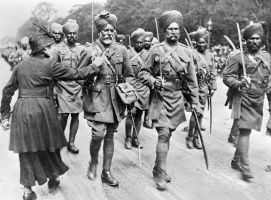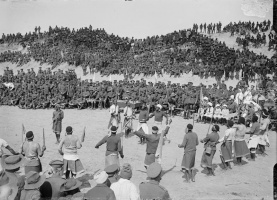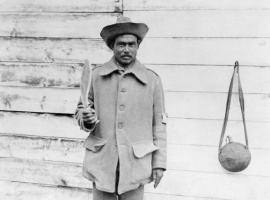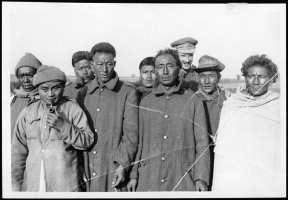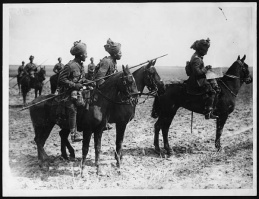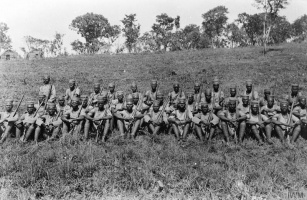The Concept of “Martial Races”↑
According to the concept of “martial races”, certain ethnic, religious, caste or social groups were regarded as possessing a more masculine character, as being loyal and therefore especially suited for military service. On the other hand, “non-martial races” were regarded as unfit for fighting. They were often members of higher castes and belonged to an educated and politicized middle class; they were thereby considered dangerous and disloyal to the British Raj. As a political and social construct, the “martial race” doctrine was used as an instrument of imperial power to legitimize and regulate colonial rule on the Indian subcontinent. It was based on cultural and racial thinking, and at the same time made use of existing "caste" distinctions, as well as religious and social ones. The concept was not only applied in South Asia, but also in Britain where, for instance, the Scottish Highlanders were defined as “martial”, and in East Africa, where the Kamba were regarded as a “martial race.”[1]
The Historical Development of the “Martial Races” Theory↑
During colonial times, “martial races” were portrayed as a scientific and fixed category[2] but recent historiography discusses “martial race” theory no longer as a static and fully developed conception but as a construct which was constantly adapted and changed by colonial military officials according to various political and military calculations.[3] Thus, Gajendra Singh uses the plural and speaks of “Martial Race Theories” which could draw on climatic, racial, class, ethnic, or religious arguments and which became manifest in military debates as well as in numerous recruiting handbooks of the Indian Army.[4] Historians argue that especially after the Indian Uprising in 1857, which had been driven by higher castes, British military officers increasingly utilized the “martial races” theory to exclude the educated populace (especially Bengalis) from military service in order to prevent further uprisings and guarantee higher loyalty of the Indian troops.[5] “From the early 1880s”, David Omissi argues, “however, the bias of Indian Army recruiting started to shift slowly and steadily towards the Punjab and Nepal.”[6] By the end of the 19th century, the main regions for recruitment had become the rural and hill areas of Punjab, the North-West Frontier, the United Provinces and the independent kingdom of Nepal. Sikhs and Punjabi Muslims, Hindu Jats, Dogras, Gurkhas, Garhwals, Pathans and Afridis were among the groups regarded as “martial”.
Conclusion↑
By the time of the outbreak of the First World War, the regional composition of the Indian Army had already changed significantly. While, in 1862, only 28 percent of the recruits for the Indian Infantry battalions came from the Punjab and the North West Frontier Provinces, this number rose to 57 percent in 1914. The number of recruits from Madras decreased from 40 percent in 1862 to 11 percent in 1914.[7] However, in the course of the First World War, when the demand in manpower rose enormously and recruitment increased, especially in the year 1917, communities which had not earlier been regarded as being “martial” were incorporated into the list of “martial races”. Whereas the number of recruits from the Punjab, the North-West Provinces and Nepal continuously grew and the number of sepoys from Madras and Bombay decreased, new groups from Rajputana, Central India, and the central Himalayan region were incorporated into the list of martial races.[8] During the war, the “martial races” policy enabled the British to maintain loyalty and constrain anti-British sentiments in the Indian Army. At the same time, the economic effects on the main recruitment regions, such as the Punjab, were devastating.
Heike Liebau, Zentrum Moderner Orient
Reviewed by external referees on behalf of the General Editors
Notes
- ↑ Parsons, Timothy H.: Wakamba warriors are soldiers of the Queen. The evolution of the Kamba as a martial race, 1890-1970, in: Ethnohistory 46/4 (1999), pp. 671-701.
- ↑ MacMunn, George: The martial races of India, London 1933.
- ↑ Roy, Kaushik: Race and recruitment in the Indian Army, 1880-1918, in: Modern Asian Studies 47/4 (2013), pp. 1310-1347.
- ↑ Singh, Gajendra: The testimonies of Indian soldiers and the two world wars. Between self and sepoy, London 2014, pp. 11-34.
- ↑ Streets, Heather: Martial races. The military, race and masculinity in British imperial culture, 1857-1914, Manchester 2004.
- ↑ Omissi, David: The sepoy and the Raj. The Indian Army 1860-1940, Basingstoke 1994, p. 10.
- ↑ Omissi, The sepoy 1994, p. 11.
- ↑ Singha, Radhika: Front lines and status lines. Sepoy and ‘menial’ in the Great War, 1916-1920, in: Liebau, Heike et al. (eds.): The world in world wars. Experiences, perceptions and perspectives from Africa and Asia, Leiden 2010, p. 71.
Selected Bibliography
- MacMunn, George Fletcher: The martial races of India, London 1933: Low, Marston & Co.
- Omissi, David: The Sepoy and the Raj. The Indian Army, 1860-1940, Basingstoke 1994: Macmillan.
- Parsons, Timothy: 'Wakamba warriors are soldiers of the Queen'. The evolution of the Kamba as a martial race, 1890-1970, in: Ethnohistory 46/4, 1999, pp. 671-701.
- Rand, Gavin: ‘Martial races’ and ‘imperial subjects’. Violence and governance in colonial India, 1857–1914, in: European Review of History. Revue europeenne d'histoire 13/1, 2006, pp. 1-20.
- Roy, Kaushik: Race and recruitment in the Indian Army, 1880-1918, in: Modern Asian Studies 47/4, 2013, pp. 1310-1347.
- Singha, Radhika: Front lines and status lines. Sepoy and 'menial' in the Great War 1916-1920, in: Liebau, Heike / Bromber, Katrin; Lange, Katharina et al. (eds.): The world in world wars. Experiences, perceptions and perspectives from Africa and Asia, Leiden 2010: Brill, pp. 55-106.
- Singh, Gajendra: The testimonies of Indian soldiers and the two world wars. Between self and Sepoy, London 2014: Bloomsbury.
- Streets-Salter, Heather: Martial races. The military, race and masculinity in British imperial culture, 1857-1914, Manchester 2004: Manchester University Press.





